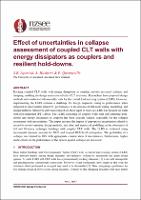Effect of uncertainties in collapse assessment of coupled CLT walls with energy dissipators as couplers and resilient hold-downs

Download
Date
2023-04-19Authors
Agarwal, Setu Raman
Hashemi, Ashkan
Quenneville, Pierre
Metadata
Show full item recordAbstract
Rocking coupled CLT walls with energy dissipaters as couplers provide increased stiffness and damping, enabling the design realisation of taller CLT structures. Researchers have proposed design methods and conducted sub-assembly tests for this lateral load-resisting system (LLRS). However, implementing the LLRS remains a challenge for design engineers owing to performance when subjected to uncertainties related to; performance in the absence of full-scale testing, modelling, and design methods. Moreover, previous research on these types of walls as LLRS was focused on walls with post-tensioned (PT) cables. The LLRS consisting of coupled walls with self-centering hold-downs and energy dissipaters as couplers has been sparsely studied, especially for the collapse assessment with uncertainties. This paper presents the impact of appropriate uncertainties related to record-to-record variation, design methods, test data, and numerical modelling on the robustness of 6,8 and 10-storey archetype buildings with coupled CLT walls. The LLRS is evaluated using incremental dynamic analysis for MCE and beyond MCE-level earthquakes. The probability of a collapse was limited to 10% with appropriate consideration of uncertainties. Furthermore, higher mode effects on the performance of the system against collapse are discussed.
